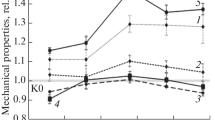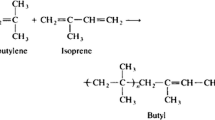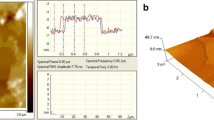Abstract
Electrical properties of butyl rubber filled with General Purpose Furnace (GPF) carbon black were studied. The carbon black concentration (X) in the compound was X = 40, 60, 70, 80, and 100 parts by weight per hundred parts by weight of rubber (phr). The corresponding volume fractions of GPF carbon black were 0.447 ± 0.022, 0.548 ± 0.027, 0.586 ± 0.029, 0.618 ± 0.031 and 0.669 ± 0.034, respectively. The concentration dependence of conductivity (\( \sigma \)) at constant temperature showed that \( \sigma \) follows a percolation theory; \( \sigma \propto \left( {X - X_{o} } \right)^{\gamma } \), where X o is the concentration at percolation threshold. The exponent \( \gamma \) was found as 6.6 (at room temperature 30°C). This value agrees with other experimental values obtained by many authors for different rubber-carbon black systems. Electron tunneling between the aggregates, which are dispersed in the insulator rubber, was mainly the conduction process proposed at constant temperature in the butyl-GPF carbon black composites. Temperature dependence of conductivity was investigated in the temperature range from 30°C up to 120°C. All samples exhibit negative temperature coefficients of conductivity (NTCC). The values obtained are − 0.130°C−1, − 0.019°C−1, − 0.0082°C−1, − 0.0094°C−1, and − 0.072°C−1 for carbon black concentrations of 40 phr, 60 phr, 70 phr, 80 phr, and 100 phr, respectively. The samples of concentrations 40 phr and 60 phr have also positive temperature coefficients of conductivity (PTCC) of values + 0.031 and + 0.013, respectively. Electrical conduction at different temperatures showed various mechanisms depending on the carbon black concentration and/or the interval of temperature. The hopping conduction mechanism was noticed at the lower temperature region while carrier thermal activation mechanisms were recorded at the higher temperature range.
Similar content being viewed by others
References
J.I. Kroschwitz, eds., Encyclopedia of Polymer Science and Engineering (New York and Chichester: Wiley, 1987).
G.A. Blokh, “Organic Accelerators and Curing Systems for Elastomers.” Int. Poly. Sci., Tech. Mono 3, Rub. Plast. Res. Ass. of G.B., vol. 2 (1981).
Avraam I. Isayev, eds., Encyclopedia of Polymer Blends, Vol. 3 (New York: Wiley-VCH Verlag, 2016).
F.D. Bostos de Sousa and C.H. Scuracchio, Mater. Res. 18, 791 (2015).
D. Saraydin, Polym. J. 29, 631 (1997).
F. El-Tantawy, Eur. Polym. J. 37, 565 (2001).
H. Tagachi, Physica B 270, 325 (1999).
P. Ghosh and A. Chakrabarti, Eur. Polym. J. 36, 1043 (2000).
J.F. Auchter, T. Schellenberg, and Y. Yoshida, Chemical Economics Handbook: Carbon Black (Menlo Park, CA: SRI Consulting, 2005).
F. El-Tantawy, A. Bakry, and A.R. El-Gohary, Polym. Int. 49, 1670 (2000).
N. Dishovsky, F. El-Tantawy, and R. Dimitrov, Polym. Test. 23, 69 (2004).
F. El-Tantawy and N. Dishovsky, J. Appl. Polym. Sci. 91, 2756 (2004).
M. Madani, J. Polym. Res. 17, 53 (2010).
S. Matchawet, A. Kaesaman, P. Bomlai, and C. Nakason, J. Compos. Mater. 50, 2191 (2016).
N. Abdel-Aal, F. El-Tantawy, A. Al-Hajry, and M. Bououdina, Polym. Compos. 29, 511 (2008).
J. Macutkevic, P. Kuzhir, A. Paddubskaya, S. Maksimenko, J. Banys, A. Celzard, V. Fierro, S. Bistarelli, A. Cataldo, F. Micciulla, and S. Bellucci, J. Appl. Phys. 114, 033707 (2013).
A. Malas and C.K. Das, J. Alloys Compd. 699, 38 (2017).
H.M. Osman, S.A. Abdel Ghani, T.M. Madkour, and A.R. Mohamed, J. Appl. Polym. Sci. 77, 1067 (2000).
G. Schwartz, S. Cervey, and A.J. Marzocca, A Numerical Simulation of the Electrical Resistivity of Carbon Black Filled Rubber. Polymer 41, 6589 (2000).
L. Karasek, B. Meissner, S. Asai, and M. Sumita, Polym. J. 28, 121 (1996).
J. Li and Jang-Kyo Kim, Compos. Sci. Technol. 67, 2114 (2007).
M.T. Connor, S. Roy, T.A. Ezquerra, and F.J. Balta, Calleja. Phys. Rev. B 57, 2286 (1998).
K.P. Sau, T.K. Chaki, and D. Khastgir, J. Appl. Polym. Sci. 71, 887 (1999).
S. Kirkpatrick, Rev. Mod. Phys. 45, 574 (1973).
D. Stauffer, Introduction to Percolation Theory (London: Taylor and Francis, 1987).
J. Janzen, J. Appl. Phys. 46, 966 (1975).
P.S. Clarke, J.W. Orton, and A.J. Guest, Phys. Rev. B 18, 1813 (1978).
J. Yacubowicz and M. Narkis, Polym. Eng. Sci. 26, 1568 (1986).
L. Benguigui, J. Yacubowicz, and M. Narkis, J. Appl. Polym. Sci. Polym. Phys. 25, 127 (1987).
J. Yacubowicz, M. Narkis, and L. Benguigui, Polym. Eng. Sci. 28, 1581 (1988).
A. Abo-Hashem, H.M. Saad, and A.H. Ashor, Plast. Rubber Compos. Process Appl. 21, 125 (1994).
T.A. Azquerra, M. Kulescza, C.S. Cruz, and F.J. Balta-Calleja, Adv. Mater. 2, 597 (1990).
F. El-Tantawy, Eur. Polym. J. 38, 567 (2002).
S. Barrau, P. Demont, A. Peigney, C. Laurent, and C. Lacabanne, Macromolecules 36, 5187 (2003).
X. Zhang, Y. Pan, Q. Zheng, and X. Yi, J. Appl. Polym. Sci. 78, 424 (2000).
J. Zhang and S. Feng, J. Appl. Polym. Sci. 90, 3889 (2003).
F. El-Tantawy, J. Appl. Polym. Sci. 97, 1125 (2005).
X. Ding, J. Wang, S. Zhang, J. Wang, and S. Li, Polym. Bull. 73, 369 (2016).
E. Asare, J. Evans, M. Newton, T. Peijs, and E. Bilotti, Mater. Des. 97, 459 (2016).
A.A. Redhwan, A.A. El-Gamal, S.A. Khairy, and H.H. Hassan, J. Thermoplast. Compos. Mater. 29, 92 (2016).
Acknowledgements
One of the authors (K.A.) wishes to express his appreciation to the Deanship of Scientific Research at King Saud University, Saudi Arabia, for supporting this work through the research group Project (RG-1436-030). The authors are very grateful to the late Prof. A.M. Lawindy for his kind help in preparing the used samples.
Author information
Authors and Affiliations
Corresponding author
Rights and permissions
About this article
Cite this article
Alzamil, M.A., Alfaramawi, K., Abboudy, S. et al. Temperature Coefficients of Electrical Conductivity and Conduction Mechanisms in Butyl Rubber-Carbon Black Composites. J. Electron. Mater. 47, 1665–1672 (2018). https://doi.org/10.1007/s11664-017-5990-y
Received:
Accepted:
Published:
Issue Date:
DOI: https://doi.org/10.1007/s11664-017-5990-y




